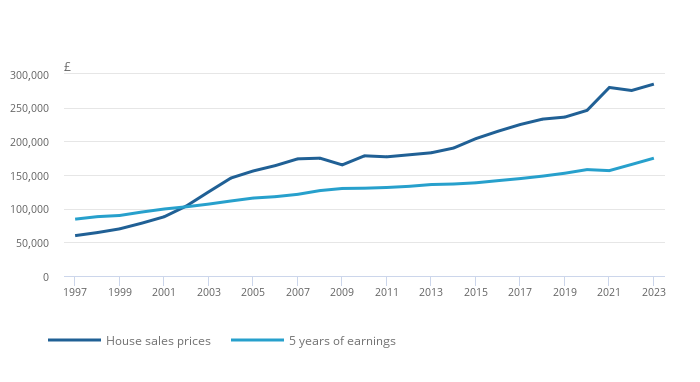Analysis: What is "affordable" housing and why do we need it?
Social factors and economic policy have driven higher demand for home ownership and higher house prices. Affordable housing provides homes at lower cost for people whose income won’t stretch to local market rates. How that is done in the UK, though, is complex.
Why do we need more homes?
The demand for housing is driven by a number of social factors:
- Population growth - estimates predict that the population of England could grow from 56 million in 2022 to 60 million in 2045
- People are living longer - there will be more elderly people, and they often need specialist accommodation
- Despite the fact that more adults are living with their parents for longer, household sizes are actually getting smaller
The Government estimates that 300,000 houses need to be built each year to keep up with this demand.
What drives the demand for home ownership?
In addition to social factors, economic factors have made ownership of a home, as opposed to rental, more attractive:
- Government policy has for decades, from both main parties, been to extend home ownership through the use of tax breaks and government-funded schemes
- Interest rates have been kept relatively low, making mortgages more affordable
- Homes are seen as attractive investments, given that they are shielded from taxes levied on other investments such as capital gains tax and inheritance tax
The effect of this is that money, which otherwise would flow into savings, pensions and the stock market, is directed to the purchase of property.
Higher demand for homes has worsened affordability
Social change and higher demand for home ownership have driven house prices far more quickly than earnings.

House sales prices and five years’ worth of earnings. (Source: Office for National Statistics)
Earnings have doubled since 1997, but house prices have increased four-and-a-half times. This is the main cause of the change in affordability, making home ownership increasingly difficult to access, particularly for first-time buyers.
What is affordable housing?
There is no single definition of affordable housing on which there is consensus, nor is there a statutory definition. The National Planning Policy Framework defines affordable housing as housing “for those whose needs are not met by the market”.
There are several sources of low-cost housing in the UK. Broadly, they are:
- New-build affordable homes
- Social housing
- Shared ownership
- Rent to buy
- Intermediate rent
New-build affordable homes must have a purchase price of up to 80% of the local market value, or rent up to 80% of the local market rate or be a “starter home” - a new dwelling for first-time buyers aged 23 to 40 only, sold at no more than 80% of market value. The National Planning Policy Framework requires that developers include a minimum 10% of affordable housing in their builds. In reality, it’s usually somewhere between 20 and 40% in most regions but in some locations, it can be up to 50%. These are the sort of affordable homes that Chilbolton Community Land Trust is likely to build.
Social housing is for people on lower incomes, who are vulnerable or have specialist housing needs. Rents for social housing are about 50% cheaper than the market rate. Providers include local councils and housing associations. Tenants pay rent to them and the providers are responsible for managing and maintaining the properties. Tenancies are generally more secure that the private rental sector.
Shared ownership is where you buy a share of usually between 25% and 70% of a home’s full market value. Buyers also need to pay a deposit on the share they own, with a mortgage for the balance. They then pay rent to a landlord for the share they own and often ground rent and service charges. Shared ownership homes are offered by housing associations, local councils, and other organisations. The downside of these schemes is that sometimes shared owners have to pay 100% of the costs of maintenance and repairs despite not owning 100% of the property. There is also the risk that, unlike rents, there is no cap on service charges.
Rent to buy is for people who can pay a rent and still be able to save money towards a future house purchase. The initial tenancy agreement is for up to two years. These schemes are run by local councils and housing associations. Intermediate rent is a specific rental subsidy product funded by Homes England which aims to allow households to rent while saving for a deposit.